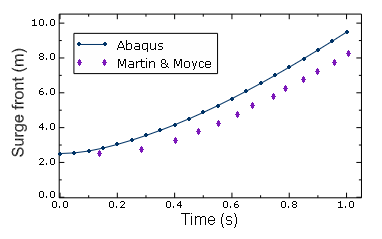Problem description
The model is created in Abaqus/CAE using a simple rectangular Eulerian domain measuring 10 × 5 × 0.05 m. Because Eulerian analyses must be conducted in three-dimensional space, it is common to approximate two-dimensional problems using a thin domain with a single Eulerian element through its thickness. Cubic elements provide the best accuracy and performance in Eulerian analyses, so the thickness is chosen to correspond to the height and width of each element in the eventual mesh.
Zero-velocity boundary conditions normal to all the domain faces prevent the flow of material into or out of the domain. The domain is partitioned, and the Eulerian material (water) is assigned to a 2.25 × 4.5 m region along the left edge of the domain (see Figure 1).
The water is modeled as a nearly incompressible, viscous Newtonian fluid. The linear Hugoniot form of the Mie-Grüneisen equation of state is used in the material model. The parameters used to define the material, based on a bulk modulus of approximately 2.246 GPa, are listed in Table 1.
In addition to a gravity load applied to the entire Eulerian domain, initial geostatic stresses are defined in the water to model the hydrostatic pressure in the column. Since geostatic stresses cannot be defined directly in Abaqus/CAE, they are added to the model using the Keywords Editor.
The Eulerian domain is finely meshed with a grid of 222 × 111 Eulerian EC3D8R elements.



